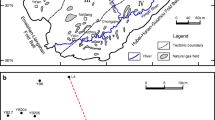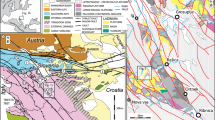Abstract
The Permian Lopingian in the Dianqiangui Basin and its adjacent areas is marked by the coal measures of the Wuchiapingian and the carbonate strata of the Changhsingian stages. For the Lopingian of the Dianqiangui Basin and its adjacent areas, the diversity of sedimentary facies and the obviousness of facies change provide an advantaged condition on a study of sequence stratigraphy. Approximately, the Wuchiapingian stage constitutes a third-order sequence and the Changhsingian stage forms another. For the Wuchiapingian stage in the study area, coal-measures were developed on the attached platform and, in addition, a special coal-measure that is composed of both limestone beds and coal beds was also developed in the central part of some isolated platforms. Grain-bank grainstones and packstones were formed on the margin of the attached platform as well as in the windward part of isolated platforms. For the Changhsingian stage in the study area, open-platform limestones were formed on the attached platform, while sponge-reef limestones were developed both on the margin of the attached platform and on the isolated platforms. The Lopingian Series is a set of basin-facies muddy shales with interbeds of silicalites in the inter-platform basin, which appears a set of the large-thick coarse clastic strata of molasses covering direct the deep-water strata from the Devonian to the Permian Yangsingian in the Qinzhou-Fangcheng region in the southern part of the study area. All of these features indicate the complexity of temporal-spatial facies-changes. Sequence-stratigraphic frameworks could be established, which would illustrate two types of facies-changing surfaces and diachronisms in the stratigraphic records, based on the combination of both biostratigraphic and chronostratigraphic materials and the regularity reflected by temporal evolutionary succession of sediments as well as spatial distributional patterns of sedimentary facies. Ultimately, features of sedimentary succession and palaeogeographical evolution of the Permian Lopingian in the study area are revealed clearly in a series of the panel diagrams of sequence-stratigraphic frameworks and the outline maps showing the sedimentary-facies and palaeogeography. The Permian Lopingian formed by two third-order sequences differs from the stratigraphy of the same era characterized by the constant regression along Euramerica. Most specially, if the end-Guadalupian mass-extinction event is genetically related to a regressive event represented by the unconformity of the first episode of the Dongwu movement in the study area, the mass-extinction event at the turn from the Permian to the Triassic is genetically related to a rapid transgressive event reflected by the drowning unconformity in the study area. These phenomena might reveal a complex relationship between mass-extinction events and transgressive-regressive events.
Similar content being viewed by others
References
Zhao Z Q, Ding Q X. The Regional Stratigraphy in Central and South Part of China (in Chinese). Wuhan: China University of Geosciences Press, 1996. 71–118
Enos P, Wei J Y, Lehrmann D J. Death in Guizhou—Late Triassic drowning of the Yangtze carbonate platform. Sediment Geol, 1998, 118: 55–76
Jin Y G, Glenister B R, Kotlyer C K, et al. An operational scheme of Permian chronostratigraphy. Palaeoworld, 1994, 4: 1–14
Jin Y G, Wardlaw B R, Glenister B R, et al. Permian chronostratigraphic subdivisions. Episodes, 1997, 20(1): 10–15
Yin H F, Zhang K X, Tong J N, et al. The global stratotype section and point (GSSP) of the Permian-Triassic boundary. Episodes, 2001, 24(2): 102–114
Huang J Q. Permian strata in south part of China. Special Report of Central Geology Survey Institute (Before 1949) (in Chinese), 1932, (10): 1–16.
Jin Y G, Shang Q H, Hou J P, et al. Chinese Stratigraphic Lexicon (Permian System) (in Chinese). Beijing: Geological Publishing House, 2000. 4–139
Gradstein F M, Ogg J G, Smith A G, et al. A new geological scale with special reference to Precambrian and Neogene. Episodes, 2004, 27(2): 83–100
Stanley S M. Earth System History. New York: W H Freeman and Company, 1999. 399–434
Shi X Y, Mei S L, Sun Y. Permian sequence successions of slope facies in southern Guizhou and their chronostratigraphic correlation. Geosciences (in Chinese), 1999, 13(1): 1–10
Mei S L, Zhu Z L, Shi X Y. Sequence stratigraphy of Permian Lopingian strata in central Guangxi. Geosciences (in Chinese), 1999, 13(1): 11–18
Yin H F, Tong J N, Ding M H. Sea level changes from the late Permian to the middle Triassic in Yangtze region. Earth Sci (in Chinese), 1994, 19(5): 627–632
Feng Z Z, Jin Z K, Yang Y Q, et al. Lithofacies Plaeogeography of Permian of the Yunnan-Guizhou-Guangxi Region (in Chinese). Beijing: Geological Publishing House, 1994. 1–129
Liu B J, Xu X S. Atlas of Sedimentary Facies and Paleogeography in South-China (in Chinese). Beijing: Science Press, 1994. 126–144
Mei M X, Xu D B. Cognition of some problems on the cyclic sedimentary records and discussion on the sequence-stratigraphic method. Geosciences (in Chinese), 1996, 10(3): 85–92
Tucker M E. Sedimentary Rocks in the Field. Chichester: John Wiley & Sons ltd, 2003. 191–224
Doyle P, Bennett M R. Unlocking the Stratigraphic Record. Chichester: John Wiley & Sons ltd, 1998. 1–532
Mei M X, Ma Y S, Dai S W, et al. Late Paleozoic filling succession of the Nanpanjiang Basin and the division of association of oil-generating strata, reservoir, and capping bed. Geosciences (in Chinese), 2001, 15(1): 74–82
Mei M X, Gao J H, Yi D H. Sequence-stratigraphic frameworks and their relative sea-level changes for the Permian of the Dianqiangui Basin and its adjacent areas. Geol J Chin Univ (in Chinese), 2002, 8(3): 18–24
Mei M X, Ma Y S, Gao J H. Sequence-stratigraphic frameworks and their relative sea-level changes for the late Palaeozoic of the Dianqiangui Basin and its adjacent areas. Geosciences (in Chinese), 2002, 16(4): 365–373
Chen H D, Wang C S, Liu W J, et al. Sequence stratigraphy and basin evolution of the Permian in South China. Acta Sediment Sin (in Chinese), 1999, 17(4): 529–535
Wang Y, Sheng J Z, Chen C X, et al. Two sections of Permian: the Bianzhai section in Qinglong of Puan county and Zisong section of Wangmo county in Guizhou province. In: The National Stratigraphical Committee of China, ed. The Corpus of Thesis on Chinese Strati Stratigraphical Congress (In Chinese). Beijing: Scien Press, 1963. 46–58
Mei M X. Discussion on the perplexity of lithostratigraphy according to the features of stratigraphic records. J Strati (in Chinese), 1996, 20(3): 207–212
Mei M X, Ma Y S. On two kinds of facies-change surface and two kinds of diachronism in stratigraphical records according to the natures of cyclic-sequences. J Strati (in Chinese), 2001, 25(2): 150–153
Ross C A, Ross J R P. Late Paleozoic depositional sequences are synchronism and worldwide. Geology, 1995, 13: 194–197
Jin Y G, Mei S L, Zhu Z L. The potential stratigraphic levels of Gudalupian/Lopingian boundary. Permophiles, 1993, 23: 281–285
Wang X D, Sugiyama T. Diversity and extinction patterns of Permian coral faunas of China. Lethaia, 2000, 33: 285–294
Hallam A, Wignall P G. Mass extinction and sea-level changes. Earth-Sci Rev, 1999, 48: 217–250
Racki G, Wrzolek T. Cause of mass extinction. Lethaia, 2001, 34: 200–202
Ali J R, Thompson G M, Song X, et al. Emeishan Baslts (SW China) and the “end-Gudalupian” crisis: magneto-biostratigraphic constrations. J Geol Soc, 2002, 159: 21–29
Wignall P G. Large igneous provinces and mass extinctions. Earth-Sci Rev, 2001, 53: 1–13
Wu Y S. Fabric-facies and fabric-rock-types of reefs. Sci China Ser B, 1992, 35(12): 1503–1511
Wu Y S, Fan J S. Calculating eustatic amplitude of Middle Permian from reefs. Sci China Ser D-Earth Sci, 2002, 45(3): 221–232
Wu Y S, Fan J S. Quantitative evaluations of the sea-level drop at the end-Permian: based on reef. Acta Geol Sin-Engl Ed, 2003, 77(1): 95–102
Chen D Z, Tucker M E, Jiang M Z, et al. Carbonate sedimentation in a starved pull-apart basin, middle to late Devonian, southern Guilin, South China. Basin Res, 2001, 13: 141–167
Wu H R. Discussion on tectonic paleogeography of Nanpanjiang Sea in the late Palaeozoic and Triassic. J Paleogeogr (in Chinese), 2003, 5(1): 63–76
Mei M X. Third-order carbonate cyclic sequence of drowning unconformity type: discussion on the condensation of carbonate platform. Sedi Fac Paleogeogr (in Chinese), 1996, 16(6): 24–33
Chen Z Q. The globally drowning events at the end of Permian. Sedi Fac Paleogeogr (in Chinese), 1995, 15(3): 34–39.
Comez J J. Condensed processes in shallow platform. Sediment Geol, 1994, 92: 147–159
Fan J S. Permian Organic-Reef (in Chinese). Beijing: Science Press, 1990. 1–419
Zhang W, Fan J S, Wu Y S. Permian Organic-Reef and Paleoecology (in Chinese). Beijing: Geological Publishing House, 1992. 1–98.
Hunt D, Tucker M E. Stranded parasequences and forced regressive wedge system tract: deposition during base-level fall. Sediment Geol, 1992, 81: 1–9
Mei M X, Yang X D. Forced regression and forced regressive wedge system tract: revision on traditional EXXON model of sequence stratigraphy. Geol Sci Tech Infor (in Chinese), 1999, 19(2): 17–21
Wang X L. Criteria for defining and recognizing the various orders of sequence in outcrop sequence stratigraphy, Sci China Ser D-Earth Sci, 2004, 47(7): 618–629
Author information
Authors and Affiliations
Corresponding author
Additional information
Supported by the State Key Project of the Ministry of Science and Technology of China and the Project of the China Petrochemical Corporation (SINOPEC) (Grant No. NPJ-100019)
Rights and permissions
About this article
Cite this article
Mei, M., Ma, Y., Deng, J. et al. Sequence-stratigraphic frameworks and their palaeogeographic patterns for the Permian Lopingian of the Dianqiangui Basin and its adjacent areas of Southwestern China. SCI CHINA SER D 50, 869–885 (2007). https://doi.org/10.1007/s11430-007-0007-y
Received:
Accepted:
Issue Date:
DOI: https://doi.org/10.1007/s11430-007-0007-y




